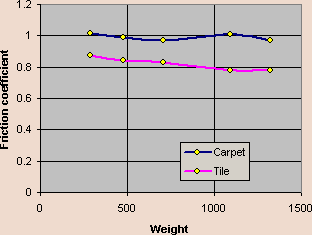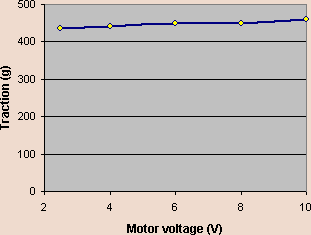Subject:
|
Re: Wheels, Tyres and Tractions
|
Newsgroups:
|
lugnet.robotics
|
Date:
|
Mon, 6 Oct 2003 08:50:59 GMT
|
Viewed:
|
3738 times
|
| |

|
|
Hi Jim,
| |
This is an extremely interesting and informative analysis.
|
Thanks ;o)
| |
Did you notice
any effects caused by the location of the scale attachment point? (snip)
|
Definitely YES. That’s why as I changed wheels I modified the test vehicule to
try to keep attachment point in line with wheel center. It is also important to
keep the retaining rope horizontal, to avoid the creation of a lifting or
pressing effect - this also has a great impact on measurements.
I also had problems in some cases with uneven pulling (probably a kind of
mechanical relaxation oscillation between full grip (high static coefficient)
and slipping (lower friction coefficient). Horizontal shift was sometimes
annoying too, with one side pulling more than the other.
As I said in my page, comparison results should be taken with a grain of salt
(who said a spoonful? well... he may be right!!!)
| |
As your “More Weight” graphs show, more weight produces more traction, but
that ‘benefit’ is offset by a corresponding decrease in the coefficient of
friction. (snip)
|
I don’t agree: as you can see from this curve, friction coefficient is quite
constant over measured range...

I must say that I was somewhat surprised to get a result that fits so well the
theoretical behaviour - though as Steve Baker pointed out, the theory behind
polymer friction is itself quite involved !
| |
It also seems like you could extrapolate a maximum weight for a wheel set,
beyond which adding additional weight would not add a significant amount of
additional traction.
|
Well, I think that the real limit lies in material strength: I actually broke an
old style z24 gear while performing this test!
| |
Finally, your “More Speed” graph implies that as long as the tires can spin,
lowering the gear ratio (increasing torque and lowering wheel speed)
actually reduces the total vehicle traction!
|
I don’t think so : traction remains the same whatever wheels rotation speed is
(provided that they rotate).

You simply have to gear down enough to make sure to avoid motors stall. Gearing
down more just slows down your vehicle when not pulling, but will not provide
more (or less) traction.
Philo
|
|
Message is in Reply To:
 | | Re: Wheels, Tyres and Tractions
|
| (...) Hello Philo, This is an extremely interesting and informative analysis. Did you notice any effects caused by the location of the scale attachment point? It seems to me that any attachment point below the axle centerline creates a lever arm (...) (22 years ago, 5-Oct-03, to lugnet.robotics)
|
13 Messages in This Thread:
    
    
      
  
      
   
- Entire Thread on One Page:
- Nested:
All | Brief | Compact | Dots
Linear:
All | Brief | Compact
|
|
|
|